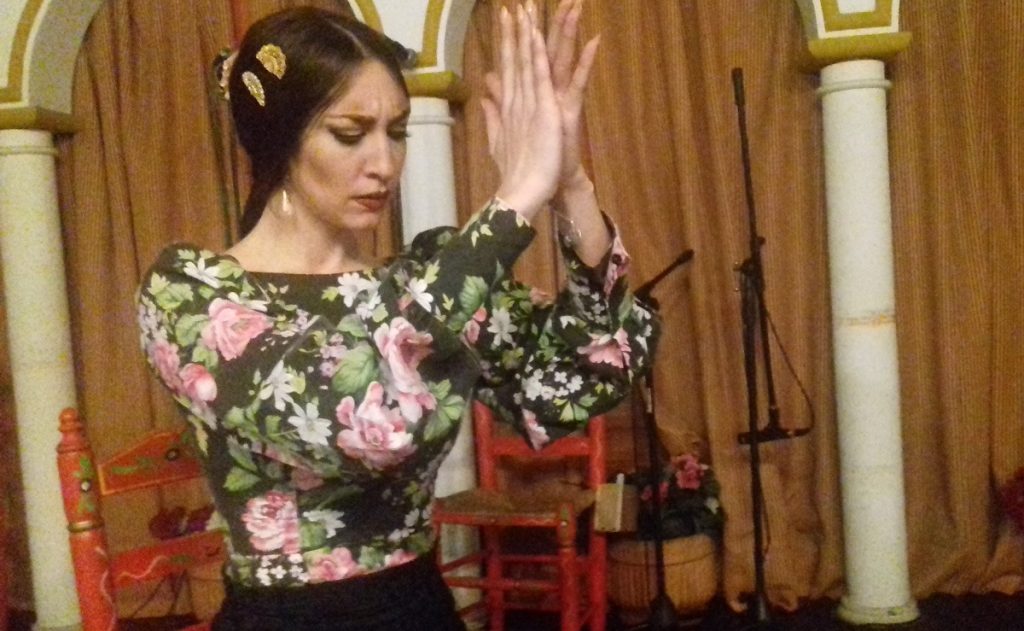
Play the palmas (flamenco hand-clapping) in time. For Alegrías, Soleá, Sevillanas, Tangos, Seguiriyas … A very flamenco expression that reveals the importance of the tap in this art. Because flamenco can also be enjoyed through the hands, one of the four pillars of jondo art: sing, dance, guitar and palmas.
The flamenco palmas are a percussion accompaniment to the flamenco singings and dancings, a rhythmic rhythm that has different styles and execution techniques depending on the flamenco style that accompanies, although not all of them are accompanied. For example, the Tonás, natural Fandangos or Cantes de Levantes do not have flamenco palmas, however, festive styles such as Rumbas, Bulerías, Fandangos de Huelva or Alegrías do.
People who dedicate themselves to this discipline are called palmeros. It requires many hours of study, practice and knowledge to accompany flamenco singing, guitar and dancing well.
Although it seems simple, the flamenco hand-clipping is the rhythmic accompaniment, hence its execution is more complex than it may seem at first glance. It is a fundamental percussion instrument, but in addition to setting the rhythm and accentuating the beat of each style, the palmas also serve to jail the singer or the flamenco dancer during their performances.
Flamenco hand-clipping is done in two ways: with the fingers of one hand striking the palm of the other or by sounding the two palms. They can be played on time or setback, but if there is one thing that can not be done is playing the palms at the wrong time because it can disrupt the singing and also disconcert the dancer.
 In a flamenco performance, the palmas are always present in one way or another, that is, either with the presence of palmeros or the hand of the singers or the dancers. It is an essential resource to mark the beat of each style.
In a flamenco performance, the palmas are always present in one way or another, that is, either with the presence of palmeros or the hand of the singers or the dancers. It is an essential resource to mark the beat of each style.
It is not the first time that we speak of compass, but remember that it is the musical unit of time that divides this into equal parts. In turn, the rhythm is the grouping of the rhythmic pattern or the metric on which the poles are made, which helps to differentiate one from the other because they mark the times or strong and weak pulses of the music.
In the case of flamenco, the compass serves to differentiate the rhythms that can be made with the palmas, the zapateado, the cajón and, above all, for singing, dancing and guitar.
In jondo art, these are 12, 4 or 3 times. Perhaps the most frequent is the 12-beat, a compass we find in clubs such as Bulería, Soleá or Alegrías, for example. To get the rhythm right, usually stronger claps are marked at times 3, 6, 8, 10 and 12, however, each flamenco club has its own characteristics.
If we take these flamenco styles as an example, in the Soleá the rhythm of 12 times have the strongest palms in 3,6,8,10 and 12, as in the Alegría. However, in the Soleá, although it has 12 times, but the strongest hits are marked in times 1, 3 and 5.
In the case of flamenco dance, the palmas are also a great accompaniment for the dancers, who even use them as another resource within their interpretations.
If you look closely, in a flamenco performance you will hear different types of palmas: simple ones and redoubling or finding them, depending on the type of club they accompany. How is this palmas accompaniment different? We explain it below.
The simple palmas, in turn, are divided into dull and sonorous palms. The deaf ones are those that are made by cupping the palms of the hands, they are strokes with a moderate sound, that mark the beat at the moment that you want to give prominence to the cante or to the sound of the guitar. They are usually used to accompany basic cantes such as Tientos or Soleá.
The sound palmas, also known as dry, strong, sharp or natural, are often used in festive singings, such as alegrías or bulerías. They can accompany any cante, especially at peak times and are often used as an accompaniment to falsetes with the guitar.
On the other hand, redoubled palms or palms are the ones that go against the palms that carry the son, that is, with the simple ones.
Touching the palmas is an art that contains more difficulty than it seems. If you want to see how palmas are played live, it is best to attend a flamenco show. In El Palacio Andaluz, you can enjoy the art of palmeo, thanks to our artists. If you visit Seville, do not miss it!
© 2024 El Palacio Andaluz. All rights reserved.